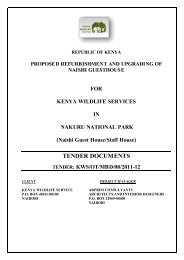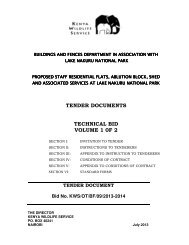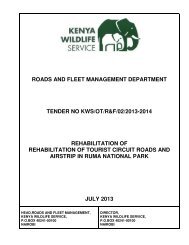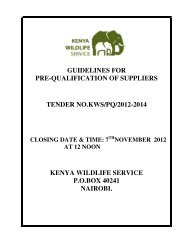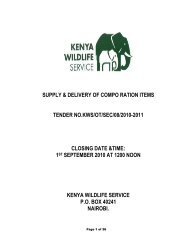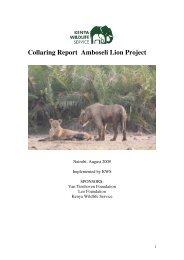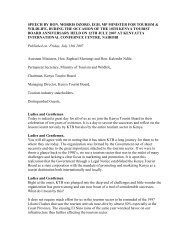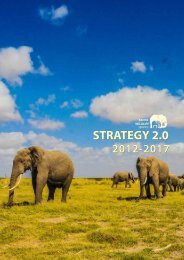Cover StoryThe future is safe forelephantsBy: SAMMI NDERITUPhoto: KWSIn 1973, <strong>Kenya</strong>’s elephant populationwas 167, 000. By 1989, that had beenreduced to 20,000 due to massivepoaching for ivory. So severe was thepoaching menace that the governmentthrough <strong>Kenya</strong> <strong>Wildlife</strong> <strong>Service</strong> increasedsecurity efforts which significantlyreduced poaching. This was also boostedby the international ban on ivory trade in1989.<strong>Kenya</strong>’s memorable symbolism of thisban in ivory trade is that of a pile of ivorythat was set ablaze by former presidentDaniel Moi at the Nairobi National Park. By2010, <strong>Kenya</strong> was estimated to have about35,000 elephants.Poaching and ivory trade aside,elephants in <strong>Kenya</strong> continue to return toparts of their former range where theyhaven’t been seen for nearly 30 years.However, the human population in thecountry has increased dramatically overthis period and the challenge of conservingelephants today is quite different to what itwas 20 to 30 years ago.The elephant range in <strong>Kenya</strong> coversalmost a fifth of the country, of whichalmost half is within protected areas. Thesubsequent increase in elephant numberscoupled with loss and fragmentation ofelephant range as a result of increase inhuman population and limited long-termland use has brought new managementchallenges.These challenges arise from conflictsbetween people and elephants as theycompete for limited resources. Theresult is habitat loss for elephants dueto confinement. These are some ofthe factors that threaten the future ofelephants in <strong>Kenya</strong>.These problems have presentedenormous challenges to KWS and otherconservationists. Although there havebeen efforts to address these issues,recent reports and happenings point to anupsurge in elephant poaching. The highdemand of ivory and its products in Asiais largely fueling illegal trade, mostly inAfrica. In <strong>Kenya</strong>, recent large seizures ofivory at the sea and airports epitomise thescale of the problem.The world is witnessing increasedillegal killing of elephants. Thesophistication and the level of organisationof illegal traders in ivory are worrying.“Last year, <strong>Kenya</strong> lost 278 elephants topoachers compared to 177 in 2010. At thesame time, more than eight tonnes of ivoryhave been seized over the last three yearsillegally traded by our law enforcementofficers,” says Dr Noah Wekesa, Minister,Forestry and <strong>Wildlife</strong>.These are some of the reasons thathave necessitated the need for a dedicatedelephant conservation and managementstrategy. KWS in partnership with variousstakeholders has officially launched anelephant conservation strategy. This wasdone in February <strong>2012</strong> at the symbolicivory burning site.The 10-year strategy, aimed atsecuring the future of elephants in <strong>Kenya</strong>,has been developed through a highlyconsultative and participatory processthat involved both local and internationalexperts.The long-term vision for the strategyis a “secure future for elephants and theirhabitats based on peaceful and beneficialco-existence with people now and forgenerations yet to come.”The overall goal for the next 10 yearsis to “maintain and expand elephantdistribution and numbers in suitable areas,enhance security to elephants, reducehuman-elephant conflict and increasevalue of elephants to people and its habitat.“The strategy is bold, ambitious andforward thinking and tackles problemsfar more complex than just the poachingissue. It involves different sectors andproposes interdisciplinary initiatives thattake into consideration the potential roleof climate change, new emerging fundingopportunities, local livelihoods and thesensitive balance that is needed in anemerging economy,” says Patrick Omondi,head of species, KWS.“This document lays the foundation forsecuring the future of the elephants forposterity not only in <strong>Kenya</strong>’s celebratedheritage but the world’s. Implementingthis strategy is not going to be easy giventhat <strong>Kenya</strong>’s human population is growingfast and thus ethical solutions need to befound for humans and elephants to coexistas they have done over millennia,” saysJulius Kipng’etich, Director, KWS.Kipng’etich further says <strong>Kenya</strong> alonecannot conserve elephants and calls forThere is need to protect elephant populations by minimising poac6
Cover Storyregional co-operation as an importantfactor for the survival of the Africanelephant to increase the numbers, securemore space and minimise human-elephantconflict.“We will work closely with otherelephant range countries on variousCITES matters and also diplomaticallyengage with consumer countries.”The Convention on International Tradein Endangered Species of World Faunaand Flora (CITES), and the Conventionof Migratory Species of Wild Animals(CMS), are some of the international legalframeworks that are used in conservationand management of African Elephantsand other wild animals.CITES is an agreement betweengovernments and recognises thatinternational co-operation is essential forthe protection of certain species of wildfauna and flora against over-exploitationthrough international trade.CMS on the other hand aims atconserving terrestrial, marine and avianmigratory species throughout their range.<strong>Kenya</strong> is a signatory to CITES and theCMS. Therefore, the launched elephantsconservation and management strategyhas been developed while reflecting onthe provisions of CITES and CMS.<strong>Kenya</strong>’s population of Africanelephants is listed in Appendix 1 of CITESand Appendix II of CMS. Under CITESAppendix I, species are threatened withextinction, which are or may be affected bytrade while under Appendix II of the CMS,species are migratory that need or wouldsignificantly benefit from internationalcooperation.“The strategy’s vision and overall goalwill be achieved by focusing efforts andresources on the following seven broadstrategic objectives, each associated witha set of specific actions and measurabletargets to gauge performance,” explainsOmondi.These are;Protection: The need to protect elephants’populations by minimising poachingthrough effective law enforcementmeasures and stakeholder collaboration.Population expansion and habitatmaintenance: Maintain and expandelephant distribution and numbers insuitable habitat where appropriate.Research and monitoring formanagement: Strengthen existingmonitoring systems and conduct priorityresearch to provide information foradaptive management and protection ofelephants and critical habitats.Human elephant conflict (HEC): EnhanceHEC mitigation by involving stakeholdersat all levels in the use of appropriate sitespecific methods.Incentives: Provide benefits thatwill encourage landowners and localcommunities to tolerate, protect andaccommodate elephants.Capacity: Sustain an effective resourcecapacity through collaborative effortsamong stakeholders with a strategic focuson priority areas.Coordination and support: Implementan effective coordination frameworkto support stakeholders and enhancedecision making and action.In actualising these objectives, thestrategy provides a clear roadmap andrecognises the need to win space forelephants in areas that have not beenencroached by settlements and farms.“It also recognises the need to offerincentives and the provision of tangiblebenefits directly linked to the presence ofelephants to communities around elephantrange areas. This will increase toleranceand custodianship of elephants amongpeople that own and use land outsideprotected areas,” notes Wekesa.The strategy also stipulates the offeringof incentives and provision of tangiblebenefits directly linked to the presence ofelephants, which will increase toleranceand custodianship of elephants amongpeople who own and use land outsideprotected areas. This has been designedto encourage landowners and localcommunities to protect and accommodateelephants.The implementation of this strategy willcontribute significantly to the successfulrecovery of elephants’ populations in<strong>Kenya</strong>.hing through effective law enforcement measures and stakeholder collaboration.7



